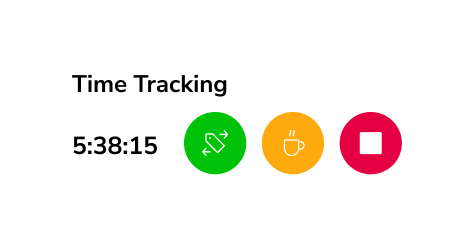This Review Covers:
- Overview
- What Do Users Like About TrackingTime?
- What Don’t Users Like About TrackingTime?
- What Pricing Plans Does TrackingTime Offer?
- What are the Standout Features of TrackingTime?
- Selected Positive User Feedback
- Selected Negative User Feedback
- What are TrackingTime’s Ratings from Review Sites?
- What’s My Final Verdict on TrackingTime?
Overview
TrackingTime is a cloud-based productivity software designed to empower businesses by addressing administrative pain points. This includes project management, attendance tracking, progress and performance monitoring, and — you guessed it — time tracking.
To streamline time tracking, the app is equipped with a flexible time tracker designed to allow users to track time anytime and anywhere from desktops, laptops, and mobile devices. TrackingTime also does a good job with project management, offering features that help you track project progress, organize tasks, and collaborate more efficiently.
All the data you track on TrackingTime can be turned into powerful insights through their project and time reports. They’re pretty detailed as far as time reports go, but the amount of information can get a little overwhelming for first time users.
Another thing users might want to be aware of is that, despite TrackingTime’s strengths, it isn’t perfect. Occasional bugs and glitches, especially on mobile, can be frustrating. Users have reported having difficulty logging in or some features just not functioning altogether.
The lack of offline functionality is another drawback, especially for users who often work in remote locations or areas with unstable internet connections.
TrackingTime is really more like an all-in-one solution for team efficiency, even branding itself as the definitive time tracking software. Now, that’s quite a big claim to make and I’ve promised you an honest review, so we’ll try to take that claim apart and discover if it has any merit.
Photo from TrackingTime
What Do Users Like About TrackingTime?
- Works on multiple devices
- In-depth reporting
- Easy to use
- Multiple integrations
What Don't Users Like About TrackingTime?
- Setup and reports have steep learning curves
- Glitches during logins
- Some features are buggy
- UI is not as intuitive
What Pricing Plans Does TrackingTime Offer?
TrackingTime has four plans: one free and three paid options. Each plan has a different set of features that are intended to address certain needs at every tier, and the higher tiers include more and arguably better features.
Paid plans start at $5.75 per user per month when billed annually and go up to $10.00 per user per month on the highest tier.
Photo from TrackingTime
The free plan, albeit limited, is intended primarily for time and task tracking for up to three users. It’s great for just basic time tracking but if you need features for task management and access to TrackingTime’s desktop and mobile apps, you’re going to need to upgrade to their Freelancer plan which costs $8 per user per month when billed annually.
Feature-wise, I think TrackingTime provides all the core tools you’d expect for basic time tracking and project management, like time entries, task assignments, and basic reporting. It’s simple, straightforward, and works well for freelancers or small teams just getting started.
That said, there are certain features that are lacking which I think would’ve added more value to their plans.
For example, GPS tracking would be a huge plus for remote teams needing location verification, and facial recognition could improve security for clock-ins. Without these, TrackingTime feels a bit behind compared to some other platforms that offer more advanced workforce management features – even at similar price points.
What are the Standout Features of TrackingTime?
1. Project Management
One of the things that I truly like about TrackingTime is the superb and thoughtful design of their project management features.
With TrackingTime, businesses can track progress, share files, and create custom reports to streamline daily work and visualize every task teams are working on. The project list and board views support team collaboration through task assignments, file sharing, and comments. To protect sensitive data, you can limit access to project data based on user roles.
Every project can be set a due date so employees are aware of client deadlines. Kanban boards are also available to help organize tasks by priority, making it easier to manage work and complete projects on time.
On top of that, TrackingTime offers Project Reports, which allow managers to monitor how much time is being spent on each project and stay on top of budgets.
Photo from TrackingTime
2. Time Cards
TrackingTime offers a time-saving functionality with its Time Cards feature.
With this feature, timecards are generated automatically from time entries captured by the time and attendance tracker on a monthly basis. Employees can submit the time cards and check the approval status with only a series of clicks. It’s all fairly easy to navigate and in case more corrections are needed, there is an option to revert the submission for further editing.
Aside from records of their clock-ins and clock-outs, timecards also contain important information about employee activities such as time off, overtime, and breaks.
For convenient file sharing and storage, the timecards can be exported easily into PDF, XLS, or CSV documents.
I must say though, that the accuracy of the timecards is based on the fidelity of the time tracker. And as per previous user feedback, it does fail sometimes. That said, it’s good that TrackingTime offers options to easily edit, regenerate, or revert time entries when needed, making it simple to fix any mistakes.
Photo from TrackingTime
3. Time Reporting
To turn time data into useful insights, TrackingTime offers customizable time reports.
There are user reports which help managers see how many hours they spent on each client, project, and task, and which tasks are in progress, completed, or overdue. Project reports, on the other hand, give you an overview of all active projects. There are also payroll reports that can be automatically generated for wages and tax compliance.
It’s great that there are also charts included, making it easier to visualize trends at a glance.
You can build a report from a timesheet, project report, or dashboard, then customize it with details, descriptions, and layouts that can be saved and reused. It’s also convenient how information can be rearranged through a simple drag-and-drop function. Once ready, reports can be shared with clients or team members through a simple link or exported as different file formats such as PDF or CSV.
TrackingTime’s reports offer a lot of detail, but the variety can be overwhelming for first-time users. While simpler templates would help, I do appreciate the depth of information—they just need a better balance between detail and a more user-friendly layout. After all, a report that’s too complicated helps no one!
Photo from TrackingTime
Selected Positive User Feedback
- “The overall function is excellent and easy to navigate. I also like how easy it is to have a little plugin next to my search bar for quick access.” – Samantha A. (Source: GetApp)
- “TrackingTime was incredibly convenient to use; its simple design made it accessible to anyone, regardless of their technical expertise.” – Emmanuella A. (Source: Capterra)
- “It really came in handy in solving team time management more so when a team has on ongoing project that has strict deadlines.” – Ciro R. (Source: Capterra)
- “I like the ability to quickly see what I’ve worked on in the past and what I’m scheduled to work on in the future. It’s also helpful to be able to track how much time I’ve spent on certain tasks so that I can accurately bill clients.” – Jesus G. (Source: G2)
- “The ability to report on project timeline performance with traceable, direct metrics was immensely helpful in justifying the business case for increased personnel and additional budgetary resources.” – Roget R. (Source: GetApp)
Selected Negative User Feedback
- “Many basic features are buggy or don’t even work at all. It’s also really frustrating that you’re unable to export timesheets from the mobile app. UI is also not as intuitive as it could be, in general.” – Olivia1524 (Source: App Store)
- “Can’t login in with Google, only shows the TrackingTime logo and nothing happens (waited 5mins). Also: internet connection can’t be the issue tested on different wifis and mobile data.” – Michael Wiedemann (Source: Google Play Store)
- “Sends daily emails and makes it difficult to manage your account on mobile.” – Nate Powell (Souce: Google Play Store)
- “Blank screen when I try to open a specific task link on mobile. Can only view in web browser which defeats the purpose of the app.” – E Play (Source: Google Play Store)
What are TrackingTime's Ratings from Review Sites?
As of April 2025
- Capterra: 4.6/5
- G2: 4.5/5
- GetApp: 4.6/5
- Software Advice: 4.6/5
- Google Play Store: 4/5
- App Store: 3/5
What's My Final Verdict on TrackingTime?
Now that we’ve taken a closer look at TrackingTime, I can say it’s a solid tool with a lot of potential—if only its issues were addressed. Its features are thoughtfully designed for the modern workplace, offering smart project management tools, easy time tracking, and detailed, visually appealing reports that help teams work more efficiently.
The project management suite is strong, providing everything needed to keep projects organized and on track. Automatically generated timecards eliminate tedious manual work and help with tax and labor compliance, while the reporting tools are packed with insights in a format that’s easy to digest.
However, TrackingTime has some clear flaws. Bugs and glitches negatively impact the experience. The tracker also doesn’t automatically stop after inactivity, so forgetting to clock out can leave the timer running for hours. Adding to the frustration, it doesn’t work offline, which limits its usefulness for fieldwork or remote job sites.
The mobile apps, meant to offer flexibility, fall short as well. They’re missing important features like facial recognition and location tracking.
In short, TrackingTime isn’t the all-in-one time tracking solution it claims to be—but it’s close. There’s real potential for growth if the team addresses its current weaknesses. If you don’t rely heavily on mobile functionality and can look past the rough edges, it’s worth trying the 14-day free trial to see if it fits your workflow.



